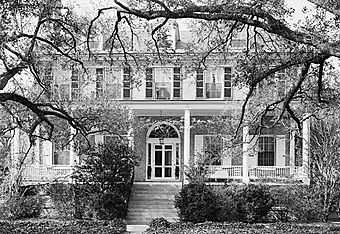Mulberry Plantation (Kershaw County, South Carolina) facts for kids
|
Mulberry Plantation (Chesnut House)
|
|

Mulberry Plantation
|
|
| Nearest city | 559 Sumter Highway, Camden, South Carolina |
|---|---|
| Area | 4,100 acres (1,700 ha) (size of NHL-listed area) 4,800 acres (1,900 ha) (size of plantation) |
| Built | 1820 |
| Architectural style | Federal |
| NRHP reference No. | 80003673 |
Quick facts for kids Significant dates |
|
| Added to NRHP | November 25, 1980 |
| Designated NHL | February 16, 2000 |
Mulberry Plantation, also known as the James and Mary Boykin Chesnut House, is a historic plantation near Camden, South Carolina. A plantation was a very large farm, often with a grand house, where crops like cotton or tobacco were grown. This special place was named a National Historic Landmark in 2000.
Mulberry Plantation is famous because it was the home of Mary Boykin Chesnut. She wrote a very important diary during the American Civil War. Her diary tells us a lot about the war from the side of the Confederacy. The main house was built around 1820. It is a great example of the Federal style of architecture.
Contents
Exploring Mulberry Plantation
Mulberry Plantation is located about 3 miles (4.8 km) south of downtown Camden. It covers more than 4,800 acres (1,942 ha) of land. This land borders the Wateree River. The main house sits on a high spot on the property. You can reach it by a drive from Sumter Highway.
The Main House
The main house is a beautiful brick building. It has 3-1/2 stories. It was built around 1820. Some people think that Robert Mills, a famous architect from South Carolina, might have helped design it. At the entrance, there is an old wrought iron gate from the early 1900s. The word "Mulberry" is spelled out in its design.
Ancient History of the Land
The land where Mulberry Plantation stands has a very long history. People have lived here since about 1250 CE. This is known from archaeological studies of platform mounds found on the property. These mounds are like ancient hills built by early people.
Experts believe this land was once Cofitachequi. This was a major chiefdom, or a powerful native community. The explorer Hernando de Soto visited it in the 1500s. There is also another important archaeological site here called the McDowell Site.
The Chesnut Family and the Civil War
The plantation was started in the 1760s by James Chesnut. It later passed to his brother John, and then to John's son, James II. Under James II, Mulberry became one of the biggest and most successful plantations in South Carolina. It grew to be over 12,000 acres (4,856 ha) in size.
James II was active in politics. He served in the state legislature. He and his wife, Mary, were important people in South Carolina society. When the American Civil War began, Mulberry was their main home. Mary Chesnut wrote many details about this place in her diary during the war years. Her diary was later published in the 1870s. It is still a very important historical book today. It tells the story of the rise and fall of the Confederacy.



